KARACHI: Like a guard in a watchtower, Nisar Khaskheli, a cotton farmer in Pakistan’s southern province of Sindh, does not let his eyes leave the horizon for long.
He is keeping a lookout for a bright yellow swarm of millions of desert locusts who inch closer to Sindh’s 200,000 acres of cotton crop every day. According to him, they are now only four kilometers away from the irrigated lands of Pakistan’s second-largest cotton producing province, and the farmers are sleepless with worry, despite the government’s deployment of aircraft and pesticide-mounted vehicles to prevent an attack on the country’s prize crop.
The emergency pesticide deployment is not unwarranted: Home-grown cotton runs Pakistan’s textile industry which is its largest job provider and foreign exchange earner. As the country struggles to stave off a balance of payments’ crisis following a bailout package from the International Monetary Fund, it cannot afford to lose its cotton, which is already forecast to fall to a 17 year low this month according to official data.
“On 25th May, we spotted the locusts for the first time when they were about 18 km away from irrigated land in Sindh,” Khaskheli, who is also president of a local agriculture chamber, told Arab News.
But within days, he said, owing to favorable weather conditions for breeding and hatching, there was a huge growth in their numbers.
“It forced us to raise alarm bells and inform the authorities,” he said.
Desert locusts, swarming short-horned grasshoppers, have been destroying crops in Africa and Asia for centuries. Their ability to move in huge swarms with great speed has earned them notoriety as one of the most devastating agricultural plagues in the world.
From the Red Sea coast of Sudan and Eritria, the locusts first emerged in January this year. By February, they had hit Saudi Arabia and Iran before entering Pakistan’s southwestern Balochistan province in March.
“Saudi Arabia quickly launched a control operation, but the undetected and uncontrolled gregarious locusts moved toward Iran,” Muhammad Tariq Khan, director of the Department of Plant Protection (DPP) at Pakistan’s Ministry of National Food Security and Research, told Arab News.
Despite a massive control operation in Iran, Khan said some unrestrained and undetected locust swarms migrated to Balochistan.
“The conditions (for breeding) were conducive for them in Balochistan due to rainfall,” he said.
Though Balochistan is not a major cotton province like Sindh and Punjab, the huge swarms of locusts have destroyed pomegranate, watermelon, grain and cotton crops in their path according to locals, though the exact extent of the damage is not yet officially known.
According to Liaquat Shahwani, Balochistan government’s spokesperson, the damage in his province has been controlled.
“Despite a massive attack, the damage was not too high,” he said, but did not share specific estimates of crop damage.
Most farmers disagreed, and said the destruction was colossal.
“They haven’t even spared the trees,” said Naseer Baloch, a farmer in Kharan, an area infested by locusts in Balochistan, alongside districts Chaghi, Washuk, Pasni, Turbat, Uthal, Dalbandin, Panjgur and parts of Kechh.
“They attack like an army and when they advance, it looks like the earth is moving,” he said.
The last major locust infestations in Pakistan were back in 1993 and 1997, though the government lacks credible statistics to quantify the damage in both instances.
After the Balochistan outbreak, the DPP says it has moved its ground control teams to launch control operations in affected areas, but that some locust groups were now moving toward the Tharparkar and Nara deserts of Sindh, and also toward India’s Rajasthan desert.
Sindh’s agriculture minister, Muhammad Ismail Rahoo, said his department found out about the locust infestation on June 3rd and was making serious efforts to safeguard its cotton crop.
It is still unclear why news of the infestation has taken so long to reach Sindh, despite crops affected in Balochistan three months ago.
“We are not big landlords, and our crop is our only source of income,” Sindh farmer Khaskheli said. “The money we make from it helps pay our bills, pay for hospitals, our children’s schools, their weddings.”
“If the locusts are not controlled, they will not just damage our crops and deprive us of livelihood,” he said. “They will wipe out billions of rupees.”
Then he shielded his eyes from the sun, and turning away, continued to stand guard over his cotton fields.
Sindh invaded by ‘army of locusts’ amid fears of cotton devastation
Sindh invaded by ‘army of locusts’ amid fears of cotton devastation
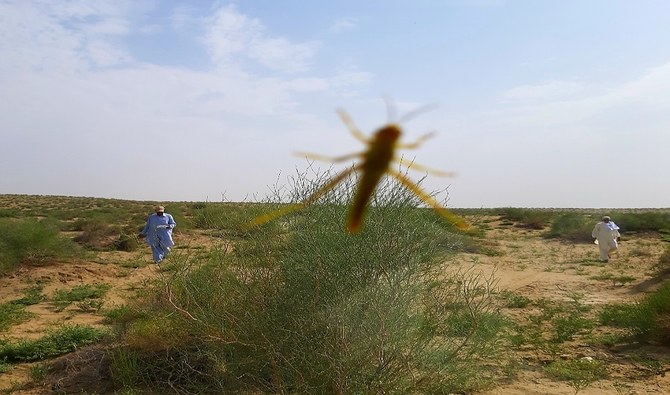
- The locust swarms migrated from the Red Sea and entered Pakistan through Iran
- Deployment of air and ground pesticide underway to control spread of infestation to Sindh’s cotton fields
Rain wipes out first Pakistan-New Zealand T20 after just two balls
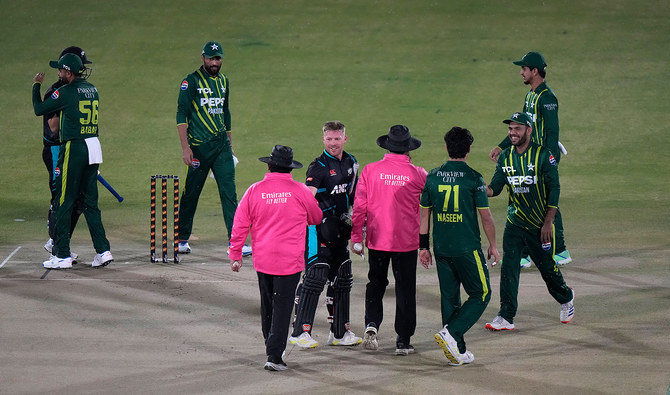
- Fast bowler Mohammad Amir returned to international cricket after nearly four years
- Having come out of retirement last month, Amir’s participation was limited to just fielding
RAWALPINDI: Heavy rain caused the first Twenty20 international between Pakistan and New Zealand to be abandoned after just two deliveries in Rawalpindi on Thursday.
New Zealand skipper Michael Bracewell won the toss, which had also been delayed by 30 minutes, and opted to bat but no action was possible for two-and-a-half hours.
Umpires Ahsan Raza and Aleem Dar then announced a five-over-a-side game at 10:10 local time (9:10 GMT).
Pakistan paceman Shaheen Shah Afridi conceded two leg-byes to debutant Tim Robinson off the first ball before bowling the batsman with a sharp delivery off the next.
But as soon as the Pakistan fielders started celebrating the wicket, the rain returned to force an abandonment.
Fast bowler Mohammad Amir returned to international cricket after nearly four years, having come out of retirement last month, but his participation was limited to just fielding.
The 32-year-old retired in December 2020 after being dropped from the side but changed his mind last month and decided to restart his career, which had already been stalled by a match-fixing ban in 2010.
Pakistan handed T20I caps to batsman Usman Khan, spinner Abrar Ahmed and all-rounder Muhammad Irfan Khan, while Robinson debuted for New Zealand.
The remaining matches are in Rawalpindi on April 20 and 21 and in Lahore on April 25 and 27.
The series gives a chance to both teams to test their bench strength ahead of the Twenty20 World Cup to be held in June in the United States and the West Indies.
New Zealand are without nine key players, including skipper Kane Williamson, who are playing in the ongoing Indian Premier League.
Five custom officials among six killed in gun attack in northwest Pakistan
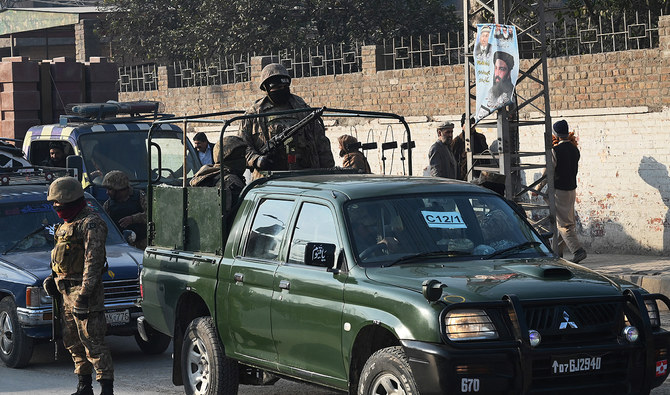
- Officials of the custom department attacked while on routine patrol in Dera Ismail Khan
- Latest killings come amid renewed violence in northwestern and southwestern regions
PESHAWAR: Six people, including five officials of the customs department, were killed and another wounded on Thursday when gunmen opened fire on their vehicle in the northwestern Khyber Pakhtunkhwa province, police and rescue officials said.
Officials of the custom department were out for routine patrol in Dera Ismail Khan city when their vehicle came under attack in the jurisdiction of Draban Police Station, Regional Police Officer Nasir Hussain Satti told Arab News.
“As terrorists started firing on the custom officials, the driver lost control of the vehicle,” Hussain said.
“As a result, their car collided head-on with another vehicle coming from the opposite direction, leaving five officials and a girl dead on the spot while one person suffered injuries.”
KP Chief Minister Ali Amin Gandapur condemned the incident.
“The incident is extremely tragic. Police should take all measures to arrest elements behind the attack,” a statement quoting the chief minister said.
Aziz Dotani, a spokesman at DI Khan district’s Rescue 1122 service, said a relief team promptly rushed to the area to transport bodies to the nearest medical facility.
The latest killings come at a time of renewed militant violence in Pakistan’s northwestern and southwestern regions, especially after the banned Tehreek-e-Taliban Pakistan (TTP) called off its fragile, months-long truce with the government in November 2022.
While there has been a spike in militant attacks across the northwest and southwest of the country, militants have particularly attacked policemen in Khyber Pakhtunkhwa in recent weeks.
Earlier this month, unidentified gunmen shot dead a policeman in the restive North Waziristan tribal district. Separately, an official working with the provincial counterterrorism department and a senior cleric affiliated with the Jamiat Ulema Islam religious political party were shot dead in two separate incidents of “targeted killings” in the North Waziristan tribal district, according to police.
While no group immediately claimed responsibility for the latest killings, suspicion is likely to fall on the TTP, which has had a significant presence in KP before being driven out as a result of successive military operations over the years. Pakistan says the TTP is now mostly based in hideouts in neighboring Afghanistan, which the Taliban denies.
Last month, seven Pakistani soldiers, including two army officers, were killed in a militant attack in North Waziristan, according to the Pakistani military. The attack led the Pakistani military to carry out rare airstrikes against suspected TTP hideouts inside Afghanistan on March 18, killing eight people. The strikes prompted Afghan forces to fire back at Pakistani soldiers along the border.
Afghan Deputy Interior Minister Mohammad Nabi Omari has urged Pakistan and the banned TTP to start negotiations afresh but Pakistan has rejected the Afghan minister’s suggestion, urging Kabul to take action against militant groups operating from its soil.
Both Pakistan and Afghanistan have traded blame in recent months over who is responsible for the recent spate of militant attacks in Pakistan.
Islamabad says the attacks are launched mostly by TTP members who operate from safe havens in Afghanistan. Kabul denies this and blames Islamabad for not being able to handle its own security challenges.
Seven killed in southwest Pakistan as heavy rains continue to wreak havoc nationwide
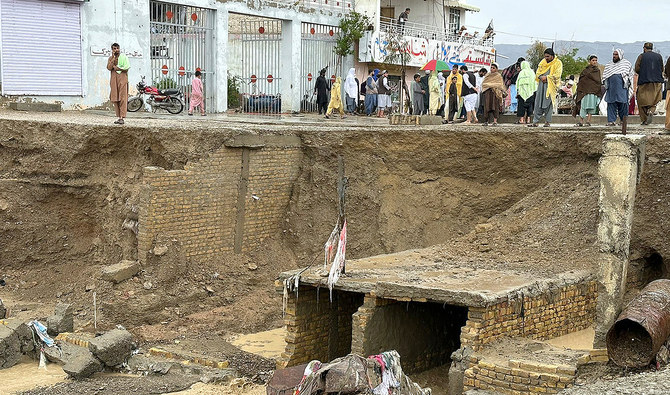
- At least 33 people killed and 46 injured in various rain-related incidents in northwestern Pakistan
- Pakistan is ranked fifth most vulnerable country to climate change according to Global Climate Risk Index
QUETTA: Seven people including a woman were killed in southwestern Pakistan as rains continue to wreak havoc in the South Asian nation ranked as the fifth most vulnerable country to climate change according to the Global Climate Risk Index.
Heavy rains in the last three weeks have triggered landslides and flash floods in several parts of Pakistan.
On Thursday, seven people were killed in the southwestern Balochistan province, officials in the town of Chaman here the deaths took place said.
“In the first incident a car drove into flood waters in Mashan Talab situated on the outskirts of Chaman,” Deputy Commissioner Chaman Raja Atthar Abbas told Arab News.
“Five men sitting inside the vehicle drowned in flood water while two people including a woman were killed after a mud wall fell on them on College road.”
Torrential rains had caused “severe damage” in Chaman and its surrounding areas as dozens of mud house collapsed in the last two days of rains, Abbas added.
Separately, at least 33 people were killed and another 46 injured in various rain-related incidents in Pakistan’s northwestern Khyber Pakhtunkhwa (KP) province in the last six days, the Provincial Disaster Management Authority (PDMA) said on Thursday.
Rains that began last Friday had completely destroyed 336 houses and partially damaged another 1,606 in different districts across the province, according to the PDMA.
The incidents occurred in Khyber, Upper and Lower Dir, Upper and Lower Chitral, Swat, Bajaur, Shangla, Karak, Tank, Mardan, Peshawar, Charsadda, Hangu, Battagram, Dera Ismail Khan and other districts.
“The deceased include 17 children, eight men, eight women, while the injured included 32 men, six women and eight children,” the PDMA said in its daily situation report on Thursday.
On Wednesday, the authority had warned of another spell of heavy rains in the province from April 17 till April 21, which could trigger landslides and flash floods.
In 2022, downpours swelled rivers and at one point flooded a third of Pakistan, killing 1,739 people. The floods also caused $30 billion in damages, from which Pakistan is still trying to rebuild.
Amir returns to international cricket as New Zealand bat in first T20I

- Amir retired in December 2020 after being dropped from the side but changed his mind last month
- Fast bowler decided to restart his career, which had also been stalled by a match-fixing ban in 2010
RAWALPINDI: Pakistan fast bowler Mohammad Amir returns to international cricket from an absence of almost four years after New Zealand won the toss in their rain-delayed first Twenty20 in Rawalpindi on Thursday.
The 32-year-old retired in December 2020 after being dropped from the side but changed his mind last month and decided to restart his career, which had also been stalled by a match-fixing ban in 2010.
Pakistan have handed T20I debuts to batter Usman Khan, spinner Abrar Ahmed and allrounder Muhammad Irfan Khan to gauge their bench strength ahead of June’s World Cup in the United States and the West Indies.
New Zealand, missing nine players due to the Indian Premier League, handed a T20I debut to batter Tim Robinson.
The remaining matches are in Rawalpindi on April 20 and 21 and in Lahore on April 25 and 27.
Teams:
Pakistan: Babar Azam (captain), Usman Khan, Abrar Ahmed, Iftikhar Ahmed, Mohammad Rizwan, Mohammad Amir, Muhammad Irfan Khan, Naseem Shah, Saim Ayub, Shadab Khan, Shaheen Shah Afridi
New Zealand: Michael Bracewell (captain), Mark Chapman, Josh Clarkson, Jacob Duffy, Dean Foxcroft, Ben Lister, Jimmy Neesham, Tim Robinson, Ben Sears, Tim Seifert, Ish Sodhi
Umpires: Ahsan Raza (PAK) and Aleem Dar (PAK)
Tv umpire: Faisal Afridi (PAK)
Match referee: Andy Pycroft (ZIM)
US says Pakistan’s prosperity and security remains a ‘top priority’
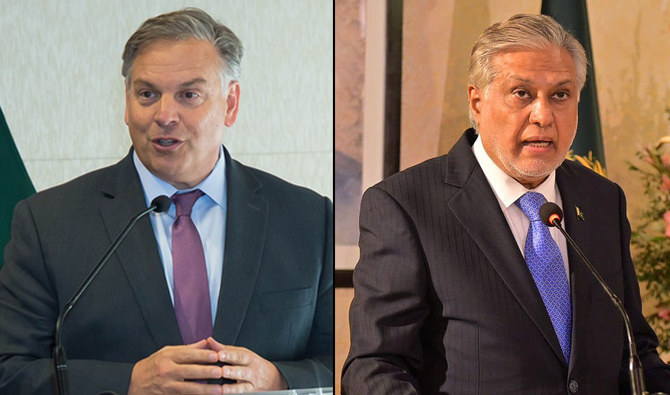
- Blome’s comments come amid a spike in militant attacks in Pakistan
- Pakistani finance chief has launched negotiations for a new IMF bailout
KARACHI: US Ambassador Donald Blome met Pakistani Foreign Minister Ishaq Dar on Thursday and said the South Asian nation’s prosperity and security remained a ‘top priority’ for Washington.
Blome’s comments come amid a spike in militant attacks in Pakistan and while its finance chief is in discussions with the International Monetary Fund in Washington on a potential follow-up program to its nine-month, $3 billion stand-by arrangement.
“US Ambassador Donald Blome met today with Foreign Minister Ishaq Dar to discuss recent events in the region,” Acting US Mission Spokesperson Thomas Montgomery said.
“Ambassador Blome conveyed the United States’ commitment to working with the government and people of Pakistan, underscoring that prosperity and security for Pakistan remains a top priority for the United States.”
Pakistan went to the polls on February 8 in a vote marred by a mobile Internet shutdown on election day, arrests and violence in its build-up and unusually delayed results, leading to accusations that the vote was rigged.
However, the US has repeatedly said it will work with the new government of Prime Minister Shehbaz Sharif, though it has expressed concerns about reported election irregularities and urged a probe.
Although defense and key foreign policy decisions are largely influenced by Pakistan’s powerful military, Sharif will have to juggle relations with the US and China.
Islamabad has close economic ties to both the nations, which has put it in a tricky position as the two countries have embarked upon a costly trade war.
“From our perspective it has to be an and-and discussion,” finance minister Muhammad Aurangzeb said in an interview this week when asked how the Sharif government plans to conduct its trading relationships with the world’s two largest economies.
“US is our largest trading partner, and it has always supported us, always helped us in terms of the investments,” he said. “So that is always going to be a very, very critical relationship for Pakistan.”
“On the other side, a lot of investment, especially in infrastructure, came through CPEC,” he said, referring to the roughly 1,860-mile-long China-Pakistan Economic Corridor designed to give China access to the Arabian Sea.
Aurangzeb said there was a “very good opportunity” for Pakistan to play a similar role in the trade war as countries like Vietnam, which has been able to dramatically boost its exports to the US following the imposition of tariffs on some Chinese goods.
“We have already a few examples of that already working,” he said. “But what we need to do is to really scale it up.”
Militancy has also spiked in recent months, creating a major challenge for the new government, with religiously motivated groups like the Pakistani Taliban as well as ethnic separatists showing an enhanced ability to hit high-value targets.
In an attack last month that has so far been unclaimed, a suicide bomber rammed a vehicle into a convoy of Chinese engineers working on a hydropower project at Dasu in the northwestern Khyber Pakhtunkhwa province, killing five Chinese nationals and their Pakistani driver.
The Mar. 26 assault was the third major attack in little over a week on China’s interests in the South Asian nation, where Beijing has invested more than $65 billion in infrastructure projects as part of its wider Belt and Road initiative.











